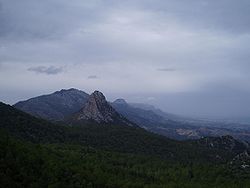
Kyrenia mountain range
Encyclopedia


Mountain range
A mountain range is a single, large mass consisting of a succession of mountains or narrowly spaced mountain ridges, with or without peaks, closely related in position, direction, formation, and age; a component part of a mountain system or of a mountain chain...
that runs approximately 160 km (99.4 mi) along the north coast of Cyprus
Cyprus
Cyprus , officially the Republic of Cyprus , is a Eurasian island country, member of the European Union, in the Eastern Mediterranean, east of Greece, south of Turkey, west of Syria and north of Egypt. It is the third largest island in the Mediterranean Sea.The earliest known human activity on the...
. The mountains are primarily limestone
Limestone
Limestone is a sedimentary rock composed largely of the minerals calcite and aragonite, which are different crystal forms of calcium carbonate . Many limestones are composed from skeletal fragments of marine organisms such as coral or foraminifera....
, with some marble
Marble
Marble is a metamorphic rock composed of recrystallized carbonate minerals, most commonly calcite or dolomite.Geologists use the term "marble" to refer to metamorphosed limestone; however stonemasons use the term more broadly to encompass unmetamorphosed limestone.Marble is commonly used for...
. The highest mountain, Kyparissovouno, is 1024 m (3,360 ft) in elevation. The western half of the range is also known as the Pentadactylos
Pentadactylos
The Pentadaktylos is a mountain mass which makes up the western half of the Kyrenia Mountains, a long, narrow chain which runs 160 km along the Northern coast of Cyprus. Both the Greek name and the Turkish name for these mountains come from the five finger-like projections of a mountain...
. Pentadactylos is also sometimes used synonymously with "Kyrenia Mountains" to refer to the entire range.
Geology
These mountains are a series of sedimentary formations from the PermianPermian
The PermianThe term "Permian" was introduced into geology in 1841 by Sir Sir R. I. Murchison, president of the Geological Society of London, who identified typical strata in extensive Russian explorations undertaken with Edouard de Verneuil; Murchison asserted in 1841 that he named his "Permian...
to the Middle Miocene
Miocene
The Miocene is a geological epoch of the Neogene Period and extends from about . The Miocene was named by Sir Charles Lyell. Its name comes from the Greek words and and means "less recent" because it has 18% fewer modern sea invertebrates than the Pliocene. The Miocene follows the Oligocene...
pushed up by a collision of the African
African Plate
The African Plate is a tectonic plate which includes the continent of Africa, as well as oceanic crust which lies between the continent and various surrounding ocean ridges.-Boundaries:...
and Eurasian
Eurasian Plate
The Eurasian Plate is a tectonic plate which includes most of the continent of Eurasia , with the notable exceptions of the Indian subcontinent, the Arabian subcontinent, and the area east of the Chersky Range in East Siberia...
plates
Plate tectonics
Plate tectonics is a scientific theory that describes the large scale motions of Earth's lithosphere...
. Though only half the height of the Troodos Mountains
Troodos Mountains
Troodos is the biggest mountain range of Cyprus, located in the center of the island. Troodos' highest peak is Mount Olympus at 1,952 metres.The Troodos mountain range stretches across most of the western side of Cyprus...
, the Kyrenia Mountains are rugged and rise abruptly from the Mesaoria
Mesaoria
The Mesaoria is a broad, sweeping plain which makes up the centre of the island of Cyprus.-Geography:The Mesaoria plain is bounded on the east and west by the Mediterranean Sea, on the south by the Troodos mountains and on the north by the Kyrenia mountains. It has an area of approximately...
plain.
History
The location of the mountains near the sea made them desirable locations for watch towers and castles overlooking the north Cyprus coast as well as the central plain. These castles generally date from the 10th through the 15th centuries, primarily constructed by the ByzantinesByzantine Empire
The Byzantine Empire was the Eastern Roman Empire during the periods of Late Antiquity and the Middle Ages, centred on the capital of Constantinople. Known simply as the Roman Empire or Romania to its inhabitants and neighbours, the Empire was the direct continuation of the Ancient Roman State...
and Lusignans. The castles of St. Hilarion
St. Hilarion Castle
The Saint Hilarion Castle lies on the Kyrenia mountain range, in Cyprus. It was originally a monastery, named after a monk who allegedly chose the site for his hermitage. Later fortified by Byzantines, it formed the defense of the island with the castles of Buffavento and Kantara against Arab...
, Buffavento
Buffavento
Buffavento Castle is located in Northern Cyprus. It means in Italian “Defier of the Winds”. The winds can reach quite high speeds in its exposed location at 950 metres above sea level....
, and Kantara
Kantara Castle
The Kantara Castle is the easternmost of the castles situated on the Kyrenia mountain range in Cyprus. Laying at 630 metres above sea level it is well positioned to control the entrances to Karpass Peninsula and Mesaoria plain....
sit astride peaks and were of strategic importance during much of the history of Cyprus during the Middle Ages
Middle Ages
The Middle Ages is a periodization of European history from the 5th century to the 15th century. The Middle Ages follows the fall of the Western Roman Empire in 476 and precedes the Early Modern Era. It is the middle period of a three-period division of Western history: Classic, Medieval and Modern...
.

